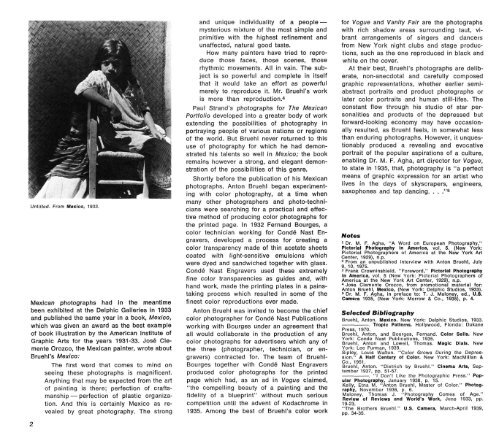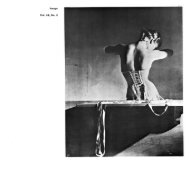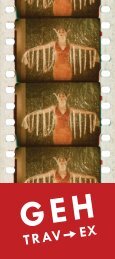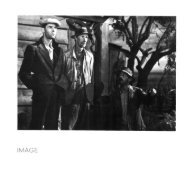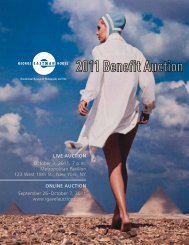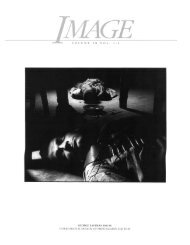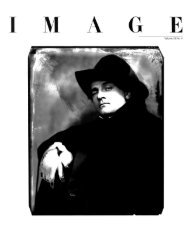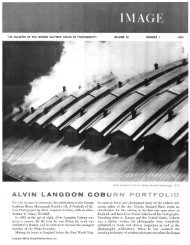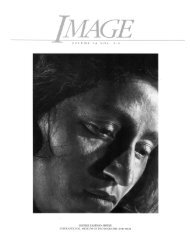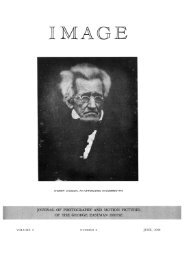Untitled - Issues of Image Magazine - George Eastman House
Untitled - Issues of Image Magazine - George Eastman House
Untitled - Issues of Image Magazine - George Eastman House
You also want an ePaper? Increase the reach of your titles
YUMPU automatically turns print PDFs into web optimized ePapers that Google loves.
Mexican photographs had in the meantime<br />
been exhibited at the Delphic Galleries in 1933<br />
and published the same year in a book, Mexico,<br />
which was given an award as the best example<br />
<strong>of</strong> book illustration by the American Institute <strong>of</strong><br />
Graphic Arts for the years 1931-33. Jose Clemente<br />
Orozco, the Mexican painter, wrote about<br />
Bruehl's Mexico:<br />
The first word that comes to mind on<br />
seeing these photographs is magnificent.<br />
Anything that may be expected from the art<br />
<strong>of</strong> painting is there; perfection <strong>of</strong> craftsmanship—perfection<br />
<strong>of</strong> plastic organization.<br />
And this is certainly Mexico as revealed<br />
by great photography. The strong<br />
2<br />
and unique individuality <strong>of</strong> a people —<br />
mysterious mixture <strong>of</strong> the most simple and<br />
primitive with the highest refinement and<br />
unaffected, natural good taste.<br />
How many painters have tried to reproduce<br />
those faces, those scenes, those<br />
rhythmic movements. All in vain. The subject<br />
is so powerful and complete in itself<br />
that it would take an effort as powerful<br />
merely to reproduce it. Mr. Bruehl's work<br />
is more than reproduction. 4<br />
Paul Strand's photographs for The Mexican<br />
Portfolio developed into a greater body <strong>of</strong> work<br />
extending the possibilities <strong>of</strong> photography in<br />
portraying people <strong>of</strong> various nations or regions<br />
<strong>of</strong> the world. But Bruehl never returned to this<br />
use <strong>of</strong> photography for which he had demonstrated<br />
his talents so well in Mexico; the book<br />
remains however a strong, and elegant demonstration<br />
<strong>of</strong> the possibilities <strong>of</strong> this genre.<br />
Shortly before the publication <strong>of</strong> his Mexican<br />
photographs, Anton Bruehl began experimenting<br />
with color photography, at a time when<br />
many other photographers and photo-technicians<br />
were searching for a practical and effective<br />
method <strong>of</strong> producing color photographs for<br />
the printed page. In 1932 Fernand Bourges, a<br />
color technician working for Conde Nast Engravers,<br />
developed a process for creating a<br />
color transparency made <strong>of</strong> thin acetate sheets<br />
coated with light-sensitive emulsions which<br />
were dyed and sandwiched together with glass.<br />
Conde Nast Engravers used these extremely<br />
fine color transparencies as guides and, with<br />
hand work, made the printing plates in a painstaking<br />
process which resulted in some <strong>of</strong> the<br />
finest color reproductions ever made.<br />
Anton Bruehl was invited to become the chief<br />
color photographer for Conde Nast Publications<br />
working with Bourges under an agreement that<br />
all would collaborate in the production <strong>of</strong> any<br />
color photographs for advertisers which any <strong>of</strong><br />
the three (photographer, technician, or engravers)<br />
contracted for. The team <strong>of</strong> Bruehl-<br />
Bourges together with Conde Nast Engravers<br />
produced color photographs for the printed<br />
page which had, as an ad in Vogue claimed,<br />
"the compelling beauty <strong>of</strong> a painting and the<br />
fidelity <strong>of</strong> a blueprint" without much serious<br />
competition until the advent <strong>of</strong> Kodachrome in<br />
1935. Among the best <strong>of</strong> Bruehl's color work<br />
for Vogue and Vanity Fair are the photographs<br />
with rich shadow areas surrounding taut, vibrant<br />
arrangements <strong>of</strong> singers and dancers<br />
from New York night clubs and stage productions,<br />
such as the one reproduced in black and<br />
white on the cover.<br />
At their best, Bruehl's photographs are deliberate,<br />
non-anecdotal and carefully composed<br />
graphic representations, whether earlier semiabstract<br />
portraits and product photographs or<br />
later color portraits and human still-lifes. The<br />
constant flow through his studio <strong>of</strong> star personalities<br />
and products <strong>of</strong> the depressed but<br />
forward-looking economy may have occasionally<br />
resulted, as Bruehl feels, in somewhat less<br />
than enduring photographs. However, it unquestionably<br />
produced a revealing and evocative<br />
portrait <strong>of</strong> the popular aspirations <strong>of</strong> a culture,<br />
enabling Dr. M. F. Agha, art director for Vogue,<br />
to state in 1935, that, photography is "a perfect<br />
means <strong>of</strong> graphic expression for an artist who<br />
lives in the days <strong>of</strong> skyscrapers, engineers,<br />
saxophones and tap dancing. . . ." 5<br />
Notes<br />
1 Dr. M. F. Agha, "A Word on European Photography,"<br />
Pictorial Photography in America, vol. 5. (New York:<br />
Pictorial Photographers <strong>of</strong> America at the New York Art<br />
Center, 1929), n.p.<br />
2 From an unpublished interview with Anton Bruehl, July<br />
9, 10, 1975.<br />
3 Frank Crowninshield, "Foreword," Pictorial Photography<br />
in America, vol. 5 (New York: Pictorial Photographers <strong>of</strong><br />
America at the New York Art Center, 1929), n.p.<br />
4 Jose Clemente Orozco, from promotional material for:<br />
Anton Bruehl, Mexico, (New York: Delphic Studios, 1933).<br />
5 Dr. M. F. Agha, in preface to: T. J. Maloney, ed., U.S.<br />
Camera 1935, (New York: Morrow & Co., 1935), p. 4.<br />
Selected Bibliography<br />
Bruehl, Anton. Mexico. New York: Delphic Studios, 1933.<br />
. Tropic Patterns. Hollywood, Florida: Dukane<br />
Press, 1970.<br />
Bruehl, Anton, and Bourges, Fernand. Color Sells. New<br />
York: Conde Nast Publications, 1935.<br />
Bruehl, Anton and Lowell, Thomas. Magic Dials. New<br />
York: Lee Furman, 1939.<br />
Sipley, Louis Walton. "Color Grows During the Depression."<br />
A Half Century <strong>of</strong> Color. New York: MacMillan &<br />
Co., 1951.<br />
Bruehl, Anton. "Dietrich by Bruehl." Cinema Arts, September<br />
1937, pp. 51-57.<br />
. "I Don't Like the Photographic Press." Popular<br />
Photography, January 1938, p. 15.<br />
Kelly, Etna M. "Anton Bruehl, Master <strong>of</strong> Color." Photography,<br />
November 1936, p. 6.<br />
Maloney, Thomas J. "Photography Comes <strong>of</strong> Age."<br />
Review <strong>of</strong> Reviews and World's Work, June 1933, pp.<br />
19-23.<br />
"The Brothers Bruehl." U.S. Camera, March-April 1939,<br />
pp. 34-35.


